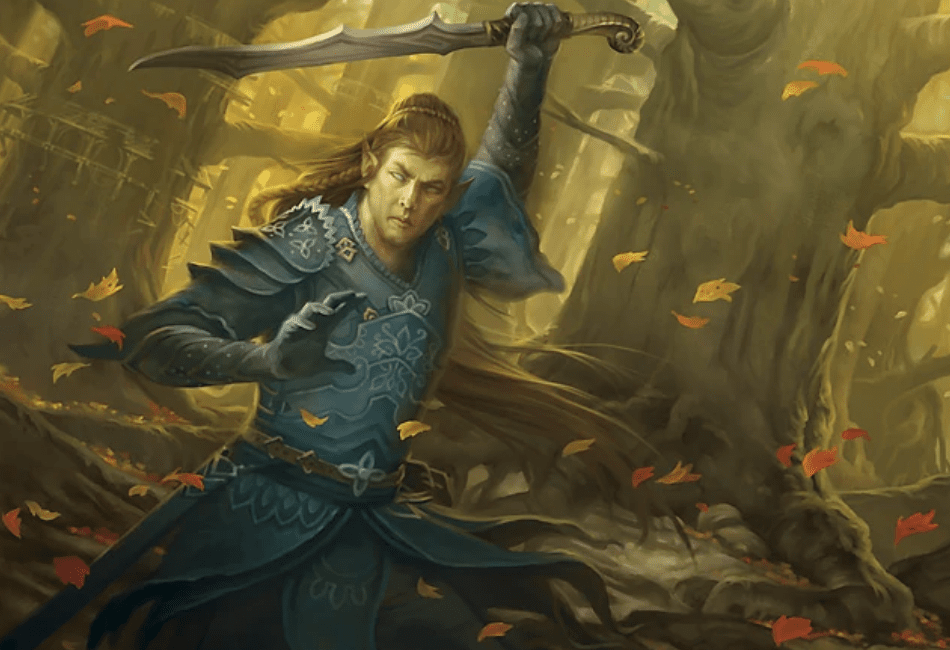Wizards have always been a tricky class for me. When I play spellcasters, I usually pick a druid, so it took a little time to get used to being unable to turn into an alligator when an angry guy got up close and personal with a sword. Honestly, I struggled. Wizards were powerful; I knew that, but I wished there was some way of building them without having to run away at the first sign of trouble.
A friend of mine knew this, so was compelled to rush over to my house one day, clutching a copy of Sword Coast Adventurer’s Guide. Wearing a gratuitous grin, he thrust it at me, telling me to turn to page 141, only cryptically adding, “Your prayers have been answered.”
He was right.
Since then, the Bladesinger has become one of my favorite classes to play. That was before the revision in Tasha’s Cauldron of Everything, which made it even more fun!
If like me, you’ve ever played an Eldritch Knight or a Hexblade and found yourself yearning for more spell levels/slots or a straight spellcaster and dreamed of being able to stand with the Fighter at the frontlines, the Bladesinger might just be waiting to dance their way into your heart.
Welcome to a Bladesinger 5e Guide.
Bottom Line Up Front
The Bladesinger is difficult to play, but tremendously versatile and powerful ‘Gish‘ class, fusing spells and swordplay into a deadly art.
A glass cannon, the Bladesinger can deal a hefty amount of damage and fill a lot of roles within a party but must be careful not to take too much damage, lest they fall. Challenging but rewarding, the Bladesinger requires a keen understanding of both melee mechanics and wizard spellcasting, and enough experience to know how to balance the two.
Key Info
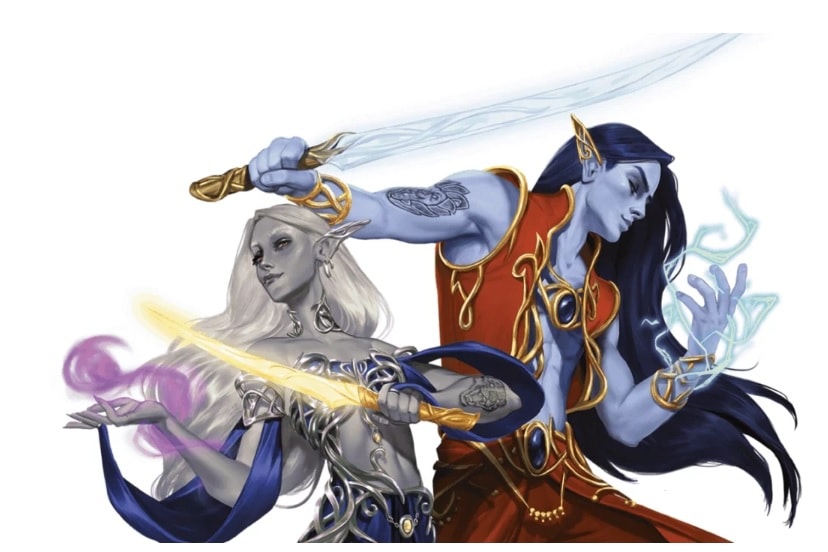
- Book: Sword Coast Adventurer’s Guide (Debut). Tasha’s Cauldron of Everything (Revised).
- Feature Levels: 2nd, 6th, 10th, 14th.
- Roles: DPS, Support.
Bladesinger Overview
Bladesingers are wizards that have mastered the art of the bladesong: an incredibly demanding fusion of swordplay and ancient elven magic. As a subject for learning, it is absent from schools and guilds, with instruction only provided from a single master to a single student. Blade in hand, they glide throughout the battlefield with movements adroit and deliberate.
Those that have seen the bladesong often describe it as the most beautiful display one can witness, likening it more to dance than a martial art. In truth, they are the same. Even the name of the bladesong comes from the whistling sounds their blades make as they slice through the air, in elegant spirals, towards their mark, dancing to a symphony that only the Bladesinger can hear.
Strengths
- Subclass of the Wizard: the strongest class in 5e.
- Jack of all trades. Tools for every situation.
- Flexible and adaptable. Unrivaled options.
- Great movement speed.
- Undeniably cool.
Weaknesses
- Low hit points, even when compared to other ‘Gish’ classes.
- Not as effective at melee fighting as a Fighter/Barbarian.
- Not as effective at spellcasting as other Wizard subclasses.
- Stats have to be spread around several ability scores to be effective.
- High skill ceiling.
Races
Traditionally, only the graceful Elven races were allowed to take up the art of the Bladesong. Since the subclass’ rework in Tasha’s Cauldron of Everything, this has been expanded to all races, reflecting the tradition’s adaptation and expansion by other cultures.
Any race can make a good Bladesinger in the right hands, but here are what I consider to be the most optimized choices.
High Elf

Naturally, an Elven race had to make it onto the list. The noble High Elf has all the aspects you would expect from the most traditional style of Bladesinger. This subrace comes with +2 Dexterity, +1 Intelligence, an extra weapon proficiency, and a bonus cantrip. These are all excellent traits for Bladesinger to have, enhancing their most important stats and abilities.
Human
Good at everything. Humans get +1 to all stats, a good choice no matter what class you play.
Svirfneblin
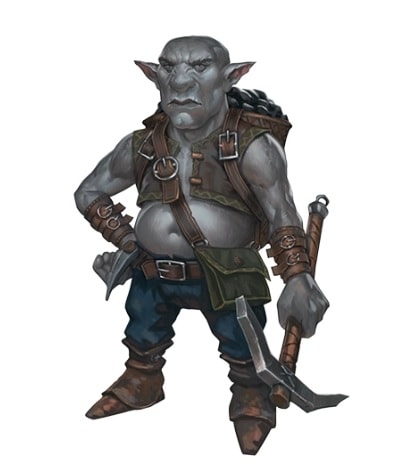
The Deep Gnome might not seem like the obvious choice for a sword-wielding spell-slinger, but its +2 Intelligence and +1 Dexterity modifier might get you to think twice before putting this subrace aside.
Superior Darkvision is a great bonus too.
Aarakocra
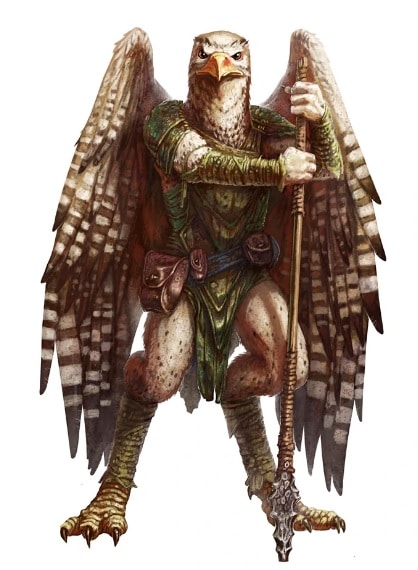
Flight. Need I say more?
+2 Dexterity and +1 Wisdom are great, but the real highlight of this class is being able to fly around with a sword and perform magical bombing runs. An absolute joy to play, if not a nightmare for your Dungeon Master (DM) to balance.
Tortle
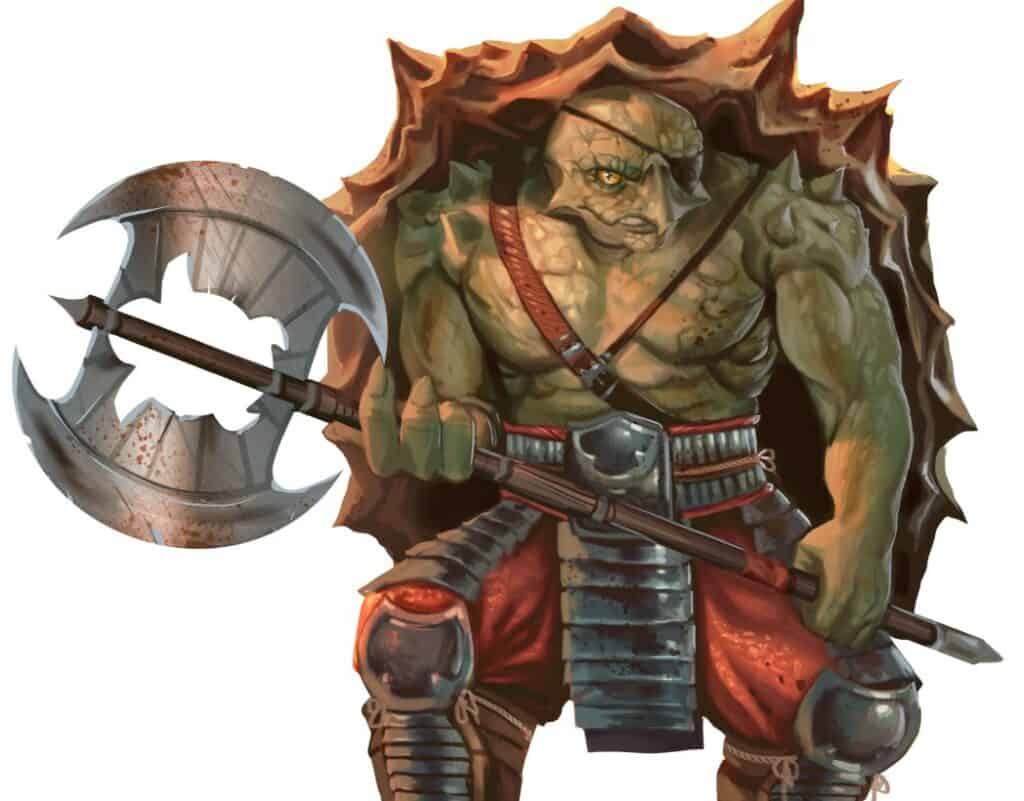
If you like the idea of a Bladesinger, but can’t bring yourself to part from a decent strength score, why not try out a Tortle? Not only is it a remarkably unique build, sure to be memorable at the table, but it also turns out to be surprisingly effective.
Tortles don’t get to add their Dexterity to their Armor Class (AC). To compensate, their hard shell gives them a base of 17 AC, meaning that you can take all the points you would have put in Dexterity and put them into Strength instead. This opens up some weapon possibilities that wouldn’t usually be viable for other Bladesingers.
You also get to withdraw into your shell, receiving a further +4 AC, great for surviving vulnerable combat positions.
Goblin
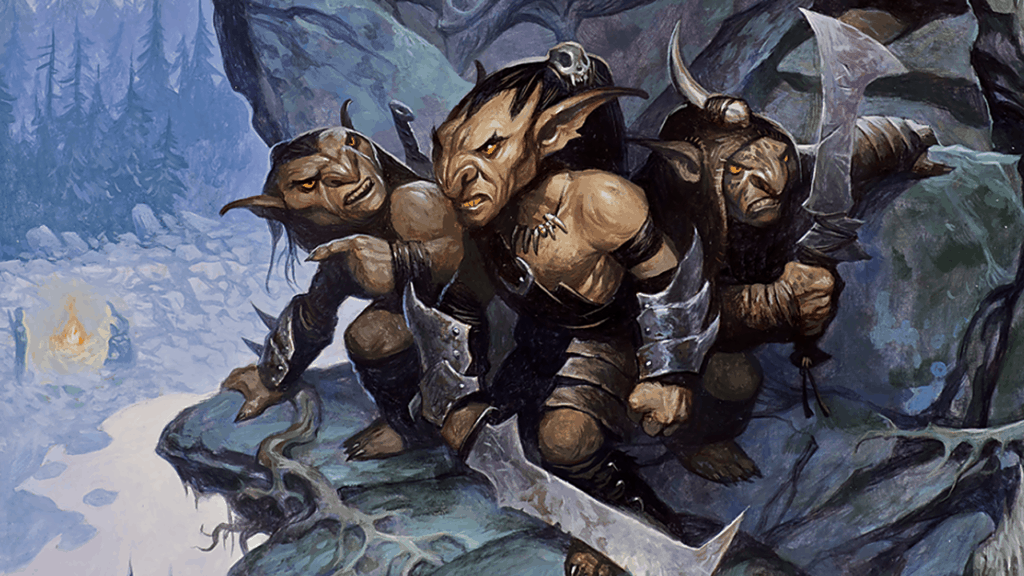
My personal favorite choice. Both unexpected and extremely powerful, the unassuming Goblin could easily be the most optimized race for Bladesingers.
The stat increases are excellent: +2 Dexterity and +1 Constitution. Nimble Escape allows Disengage and Hide actions to be used as bonus actions, which helps keep you out of harm’s way. Fury of the Small grants the ability to cause more damage to any target of a larger size than you (which is practically everything).
A Goblin Bladesinger might be a little too unorthodox for some tables, so check with your group if you plan on using one. If you’re a DM instead and looking for a distinctive boss encounter or villain for your adventurers, I can heartily recommend the ‘Gobsinger.’ Your players will never expect it!
Stats
Unlike the overtly charismatic Hexblade, the Bladesinger can’t simply shove all their ability points into one stat and call it a day. Spreading them around is the name of the game. Getting that balance can be tricky, so I’ll break down each stat with how important I believe them to be.

Strength
Unimportant.
Unless you’re playing a Tortle, mostly disregard this stat. Make it 10 if you can, so you avoid negatives to your damage rolls.
Dexterity
Second-most priority.
Your melee attack rolls will rely on this stat, as will your AC. Make it high.
Constitution
Third-most priority.
This stat will give you some much-needed hit points, key in helping you maintain spell concentration in combat.
Intelligence
Top priority.
Many of your class features and spells rely on this stat. Spells, melee damage, and AC will all gain bonuses from this stat as you progress. Make this the highest.
Wisdom
Fourth-most priority.
Handy for certain saving throws, but mostly superfluous.
Charisma
Unimportant.
If you like chatting with NPCs and influencing them with persuasion and deception, you can put a few points in this stat. Otherwise, it’s almost entirely useless.
Example Stat Block
For an idea of how your stats should look, here’s an example using a standard array:
- Strength – 10
- Dexterity – 14
- Constitution – 13
- Intelligence – 15
- Wisdom – 12
- Charisma – 8
Class Features
2nd Level
Training in War and Song

When you first take the Bladesinger subclass, you instantly gain proficiency in light armor and your choice of a one-handed melee weapon.
If you’ve taken my advice and prioritized Dexterity over Strength, you’ll need to choose a weapon with the Finesse attribute. I recommend the rapier, as it boasts respectable damage. A shortsword does a little less but comes with the Light attribute, making it perfect for dual-wielding. If you’d like to dual-wield but prefer slicing your enemies up, the scimitar brings slashing damage and is also Light.
- Rapier – 1d8 piercing damage – Finesse
- Shortsword – 1d6 piercing damage – Finesse, Light
- Scimitar – 1d6 slashing damage – Finesse, Light
If you’re looking for a weapon with bludgeoning damage and Finesse, I’m afraid I have some bad news for you: it doesn’t exist. Speak with your DM about allowing a special weapon with these attributes if your heart is set on it.
You also gain proficiency in performance. After all, we can’t let the bard have all the fun.
Bladesong
This is why we chose this subclass.
When active, the Bladesong grants you bonuses designed to give you more survivability in melee encounters, with extra AC making you harder to hit, increased movement speed helping you get away from tough fights, and enhanced concentration allowing you to take damage without dropping spells.
Though none of this will make you as good as a fighter in a straight-up brawl, being able to dip in and out of direct combat allows for a more skirmisher-style approach. The aim is to safely harass enemies, falling back and throwing spells from afar when threatened.
6th Level
Extra Attack
Similar to the fighter feature, this allows you to attack twice in a single action. However, this one lets you substitute one of these attacks for a cantrip.
You can choose to cast the cantrip either first or second, opening up some crazy combinations. Strike an enemy before you, then hit another with a Fire Bolt. Lock down a powerful foe with Booming Blade and then hit him again for good measure. All this can be yours for the low, low price of a single attack action!
10th Level
Song of Defense
Great for boosting your survivability. This feature essentially acts as a panic button, negating damage that you might not be able to take otherwise.
The price is a steep one, though. Your bladesong must be active, it requires your reaction to perform, and it costs a spell slot. Burning through slots this way is far from your best option, and your reaction can be better spent on other ways of defending yourself, such as Absorb Elements or Shield.
Don’t get me wrong: this is still a great feature to have. Just don’t use it too much if you value your spells. It’s great to have that buffer for a class with so few hit points, but using it too often runs the danger of turning you into nothing more than a bad fighter with a few cantrips.
14th Level
Song of Victory
This allows you to add your Intelligence modifier to your melee damage rolls while your bladesong is active. This is great for boosting your damage output, but keep in mind that this bonus doesn’t apply to your attack rolls; you’ll still need to rely on your Dexterity for that.
Recommended Feats
War Caster
The quintessential ‘Gish’ feat. If you’re only going to take a single feat, make it this one.
Gettingan advantage on your constitution saving throws to maintain concentration pairs extremely well with the bonus you already get from your bladesong, meaning that you’ll rarely lose a spell from taking damage, if at all.
Not having to worry about somatic components means that you can dual wield and still cast spells, should you want to. Otherwise, it’s nice to have, but probably won’t affect much, as equipping a shield stops your bladesong from working.
It’s the last part of this feat that stands out. Being able to deal someone a Finger of Death because they dared to move past you is ridiculously strong, but even a cantrip can be surprisingly useful here. Hitting someone with Booming Blade as they try to move past you means they either have to stop immediately or take a significant chunk of thunder damage.
Elven Accuracy (Elf/Half-Elf Only)
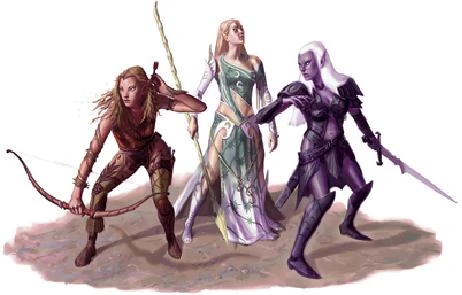
If you’ve chosen the elven races, this feat is a must-have. With it, you essentially get super-duper-advantage!
Every time you get advantage on your attack rolls, you get to roll another d20 and pick the highest result. That’s 3d20. Needless to say, you’re unlikely to miss.
It also comes with a free ability point. Put it into Intelligence or Dexterity: whichever you think is best.
Telekinetic
An excellent ability that fits the Bladesinger, both thematically and mechanically. Not only do you get the Mage Hand cantrip (or a more powerful version if you already have it), but you also get to push people around with only the power of your mind!
This feat is excellent when paired with Booming Blade, as you can use the cantrip to lock down enemies before pushing them out of melee range.
Similarly, this feat can push an ally out of harm’s way, as the push itself doesn’t cause any outright damage, and the target can choose to fail the saving throw.
If you’re a Star Wars fan, you have another reason to take this feat, which you may have already thought of: A Bladesinger with Telekinetic is as close to a Jedi as you can get in 5e. For extra points, try getting your hands on a Sun Blade.
This feat also comes with a free ability point. Intelligence is the best place for it.
Tough
This feat isn’t fancy, but it provides something that the Bladesinger lacks quite a bit: hit points. Take this feat if you’re feeling a little too squishy.
Fighting Initiate
This feat gives you a fighting style from the fighter class to claim as your own. This can help a lot in supplementing your melee fighting capabilities. There is a lot to choose from, and all have their strengths.
Two-Weapon Fighting is great for dual-wielders, Duelling will give you some extra damage, and Mariner is great for defense and maneuverability.
Recommended Spells
The Bladesinger is a wizard first and a melee combatant second. Rushing into combat without any spells is not a good idea. At best, you’ll end up playing what amounts to a sub-par bard. At worst, it’ll get you killed.
That said, the Bladesinger is more adept at being on the front lines than any other subclass of Wizard, which means we can take advantage of some more specialized, melee-focused spells.
Cantrips
Booming Blade
An excellent lockdown tool. Hit an enemy with this, and they can’t move without taking thunder damage. Effective in disrupting enemy formations and tactics, this spell forces foes into the unenviable choice between a complete lack of mobility and losing health.
Green-Flame Blade
If you’re against two combatants in melee, this spell will allow you to damage them both, your initial target taking regular attack damage and the second taking fire damage. Between this cantrip and Booming Blade, you’ll always have a reliable option for melee damage.
Fire Bolt

Having a decent ranged cantrip is essential. Shooting off bolts while pulling back from the fray doesn’t just look cool: it also keeps you alive!
Minor Illusion
Quite possibly the best utility spell in 5e. The ability to create sounds and images (that can be pretty much whatever you need them to be) has almost infinite uses. Once, in a campaign with another wizard that had also taken Minor Illusion, we managed to distract an entire town of people by staging a mock fight, throwing illusionary “Fire Bolts” at each other until our rogue had robbed the crowd blind. A little creativity can make this cantrip shine.
Furthermore, with the ability to create musical notes, your bladesong can now take on a more literal meaning with the aid of instrumental accompaniment. There’s no overtly tactical use for this, but I’ve still found myself doing it in previous campaigns, if only for the style points and to get some actual use out of that performance proficiency.
Level 1
Find Familiar

A good spell for wizards. For a Bladesinger, it’s godlike.
Your familiar can’t attack, but it can perform any other standard action. The most helpful of these is, funnily enough, the help action, which can be used to give yourself advantage on attacks.
They can also give an advantage on ability checks. Planning on using a fireball spell, but see that one of your companions is in the blast zone? Consider using your familiar to give them an advantage on their dexterity, and saving throw, potentially resulting in them taking half damage while simultaneously immolating a dangerous mob of creatures.
Though most familiar forms have their strengths, I strongly recommend the owl. Not only does it get a flight speed and Superior Darkvision, but it also gets the trait Flyby, which completely negates all attacks of opportunity that would otherwise result from it flying away from enemies.
Shield
Probably the best defensive spell in 5e and an excellent choice for your reaction.
Whenever you take an attack that would hit you, instantly shove on an extra +5 AC, potentially making that attack miss completely. The immunity to Magic Missile is a great bonus, as it never misses otherwise.
Absorb Elements

Another great reaction option. Cast this whenever you get hit by elemental damage to cut the damage in half. It’ll also apply a temporary buff to your next melee attack, infusing it with the damage type of whichever element just hit you. Giving enemies a taste of their own medicine is always satisfying and rarely ineffective.
Level 2
Shadow Blade
A sword of psychic energy, blessed with the Finesse and Light properties. In other words, an ideal Bladesinger weapon.
It only takes a bonus action to cast and can be thrown and called back to your hand. It also gives you advantage on every attack you make with it in low light or darkness.
Misty Step
Teleportation spell that only takes up a bonus action. Excellent for getting out of tight spots or past enemy formations.
Flaming Sphere

When paired with Booming Blade, this spell can present some unpleasant decisions for your enemies, forcing the choice between staying still and taking fire damage or moving and taking thunder damage. More generally, it’s excellent for controlling space and adding to your damage output.
Level 3
Haste
Cast this on yourself for +2 AC, advantage on dexterity saving throws, and an extra action each turn. A powerful buff, but at the cost of skipping a turn once the spell ends. Plan ahead, know the risks, and use this spell wisely.
Counterspell
There’s no better feeling than stopping a spell in its tracks, particularly when it could have wiped out your party. Use this to shut down other spellcasters before cutting them down with your blade.
Spirit Shroud
A multifaceted debuff spell. Extra damage, cutting movement speed, and denying the ability to heal makes this the go-to crowd control spell.
Level 4
Greater Invisibility
Invisibility that persists for as long as you maintain concentration. Using this in combat gives you advantage on all your attacks, and disadvantage on any attacks that come your way.
FireShield
A defensive spell that deals damage, granting resistance to either fire or cold, but also the ability to give that damage type back to anyone foolish enough to strike you in melee.
Stoneskin
Enhances you with physical resistances, giving you a defensive edge in combat. It lasts for an hour, provided no loss in concentration, but magic weapons will cut right through it.
Level 5
Animate Objects
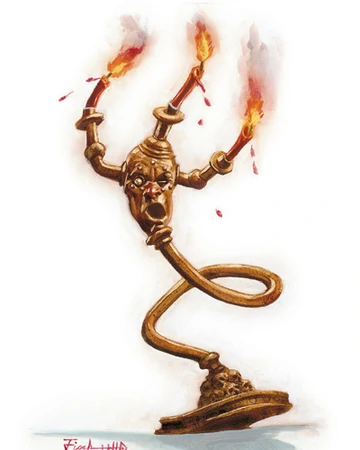
This spell allows you to create minions out of everyday items. Keep a collection of knives, throw them onto the floor, then cast this spell. This will give you 10 flying companions, all with their attack, AC, and hit points. If that sounds powerful, that’s because it is.
It’s also thematically satisfying: the Bladesinger, daggers circling the air around them as they dance throughout the battlefield.
Far Step
This spell gives you a free Misty Step every turn for a minute, with the distance doubled.
Thought your mobility was good before? Wait until they get a load of this.
Steel Wind Strike
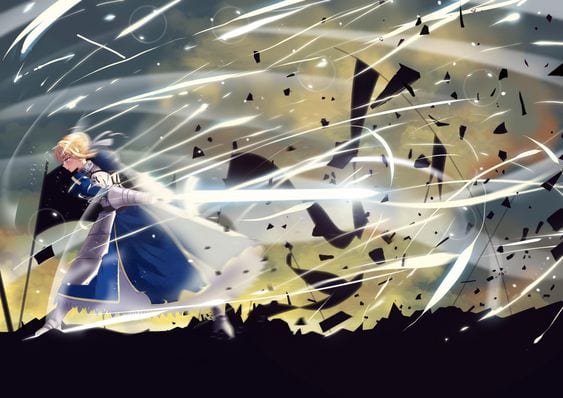
Yet another teleportation spell, but one far too good to ignore. Vanish before dealing massive damage to multiple targets, reappearing before them as they fall. This spell has Bladesinger written all over it.
Level 6
Tenser’s Transformation
This spell provides numerous buffs that make you a force to be reckoned with in combat. Temporary hit points, advantage on attack rolls, and extra damage all combine to form a melee combatant worth fearing.
It’s not without its price, however. You’re unable to cast any spells for its duration, and once it’s over, you run the risk of incurring exhaustion if you roll badly on a constitution save.
Save this spell for when you’ve run out of spells, or want to commit wholeheartedly to the frontlines.
Contingency
This spell can be a little difficult to understand at first, but it has a lot of uses once you get the hang of it.
Essentially, it gives the ability to trigger another one of your spells when specific criteria have been met. For example, you could tie Tenser’s Transformation to your health, coming into effect when you take a particularly debilitating blow.
You could set Fire Shield to activate when you become engulfed in flame, saving you from half the damage. You could even trigger Haste at the sound of a starter’s gun, giving you an unfair advantage in a footrace. With a little imagination, this spell pays dividends, albeit at the cost of two spell slots.
Level 7
Crown of Stars
Excellent for raw damage output. Casting this will allow you to convert bonus actions into big bursts of radiant damage.
Prismatic Spray
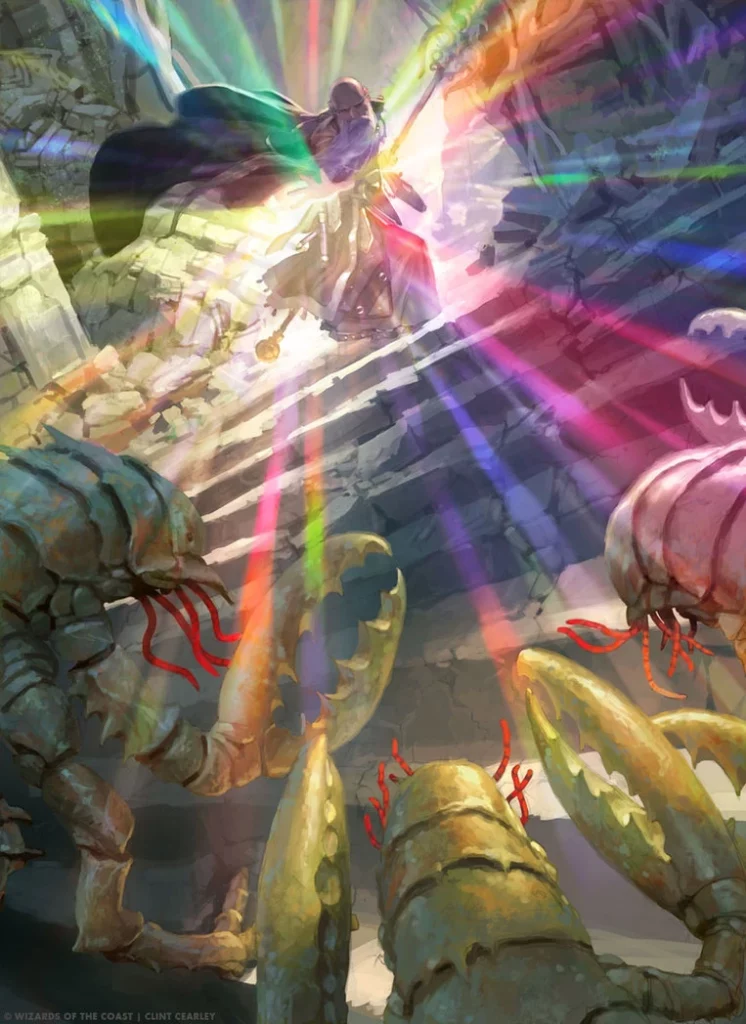
The effect of this spell might be random, but all of them are powerful. You’ll rarely be disappointed with the outcome. I find the best use for this spell is for finishing off groups of enemies that are low on health.
Level 8
Power Word Stun
Stuns any creature that has 150 hit points or fewer. There’s no save. It just happens.
Afterward, they must make a constitution save to stop it from happening again. This repeats at the end of each of their turns. If they never make the save, they’re stunned forever.
Maze
Banishment is a powerful tool in combat, as you can eliminate troublesome targets, if only temporarily. Getting rid of the big, tough guy before trimming down the small fry can turn an impossible encounter into a manageable task.
Level 9
Blade of Disaster

Now you have access to level 9 spells, why not take this incredibly damaging summon spell?
Invulnerability
Why bother with gigantic amounts of damage when you can resist damage altogether?
Time Stop
Why bother resisting damage when you can make time itself grind to a halt?
Wish
Why bother with time when you can bend reality to your will?
FAQs
Question: Is Bladesinger official?
Answer: Yes, Bladesigner is 100% official. No homebrew required.
Question: What book is Bladesinger in?
Answer: Bladesinger originated in Sword Coast Adventurer’s Guide, with a revised version later appearing in Tasha’s Cauldron of Everything, buffing the subclass in a few areas.
Question: Is Bladesinger OP/Broken?
Answer: No. Though undeniably powerful, the Bladesinger has many weaknesses that the player must be aware of and compensate for. A low charisma score means you’ll rarely be the voice of the party. An underwhelming strength score means it’s easy to overpower them physically. This spread of abilities means they can’t truly excel in any one area. Bladesingers excel in the hands of those that can utilize their versatility, but without that creative spark, they are underpowered, if anything.
Question: Can Bladesinger use a longsword/shield?
Answer: They can, but it’s generally against their best interests. Equipping a shield invalidates your bladesong, making it impossible to use. Similarly, a longsword lacks Finesse, meaning you’ll be under-utilizing one of your best stats, as you’ll be unable to replace Strength for Dexterity in determining attack rolls.
- Best DnD Character Builders Online - November 20, 2022
- The Best DnD 5e Character Builder Sheets - October 9, 2022
- Scimitar 5e Guide: Curved Swords - September 27, 2022

